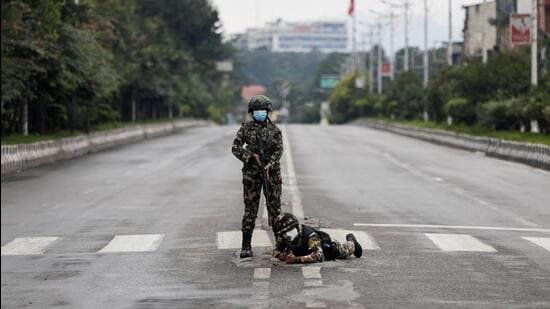Tens of thousands of demonstrators, describing themselves as Gen Z, converged near the parliament in Kathmandu on September 8, to protest against a ban on 26 social media platforms (including Facebook, WhatsApp, X, Instagram, Reddit, LinkedIn, Signal and YouTube) announced last week for failing to register under the new government guidelines. Even as the police resorted to batons, water cannons, and rubber bullets to disperse the protestors, the crowds continued to grow and by the end of the day, 20 young people (including a 12 year old) were dead, with reports of 400 injured.

The following day, anger had spread to other cities and government buildings, including the parliament and Singha Durbar, were set on fire. Private houses of leading politicians, cutting across party lines, were torched, cars burnt and ministers manhandled. Home minister Ramesh Lekhak had accepted responsibility and resigned on September 8 and the ban order was also reversed but the protestors were not satisfied. Finally, Prime Minister K P Sharma Oli realised that he needed to go and he resigned on September 9 in the afternoon. There are rumours that he was evacuated in a helicopter by the army to a secure location as his official residence at Baluwatar was considered vulnerable.
Nepal’s political transition has been a long time in the making and has gone through multiple phases. It began with the popular uprising in 1990, labelled as Jan Aandolan 1, leading to a new constitution that laid the foundations of a multiparty democracy by curbing the role of an absolute monarchy into a constitutionally circumscribed role. However, in the mid-1990s, a Maoist insurgency began to take shape in some of the poorer hill areas that gradually took hold and spread. Infighting between the political parties and the palace provided a permissive environment for the insurgency to spread and by 2006, it had claimed 17,000 lives.
In 2005, King Gyanendra declared a state of emergency, dissolved parliament, dismissed the elected government, and assumed direct rule. A popular pushback led to Jan Aandolan 2 in 2006 that forced him to restore parliament. A peace process between the political parties and the Maoists, facilitated by India, led to the Maoists coming overground and emerging as a political party. Elections for a Constituent Assembly (CA) took place in 2008. The 240-year-old monarchy was abolished, Nepal emerged as a republic, and the CA began work on a new constitution for a ‘Naya’ (new) Nepal.
After seven years, Nepal adopted its new constitution but the promise of a New Nepal remains a distant dream. A key reason has been weak economic development, lack of employment opportunities, growing corruption, and frequent changes of government. In the 17 years since it became a republic, Nepal has had 15 governments. The situation didn’t improve even after 2015 when the new constitution was adopted, with the last decade accounting for nine of the 17 governments.
Part of the reason is that in none of the elections since 2008 did any party manage to obtain a clear majority, necessitating coalitions. This explains the political instability of short-lived coalitions. However, there has been a strange stability too, in that the leaders of the three major parties, Nepali Congress (NC), United Marxist Leninist (UML), and Maoist Centre, have been taking turns in leading the incestuous coalitions and garner the loaves and fishes of office. In the process, corruption grew visibly and the groundswell of public disenchantment was just waiting for a spark that was provided by the ill-conceived ban on the 26 social media platforms, leading to Jan Aandolan 3.
However, there are differences. The earlier two Jan Aandolans were spearheaded by the political parties, primarily the NC and the UML, had the clear objective of wresting political power from the monarchy, and had an identifiable leadership. The Jan Aandolan 3 rejected the leaders of all political parties and there have been calls for dissolution of the parliament and even revising the constitution.
Second, there is no visible leadership. The 35-year-old Balen Shah, a rapper turned electoral phenomenon who became the surprise winner of the mayoral election in Kathmandu in 2022, is trying to emerge as a leader in Jan Aandolan 3. On September 7, he conveyed support to the protestors and after keeping quiet for a day, came out after PM Oli’s resignation, urging restraint.
Another name doing the rounds is the 38-year-old Sudan Gurung, who founded the non-governmental organisation Hami Nepal (Our Nepal) in 2015 following the devastating earthquake to ensure that humanitarian assistance was delivered efficiently where it was most needed by mobilising youth volunteers. During the past decade, his NGO was successful in mobilising resources for communities impacted by floods and landslides that take place with depressing regularity. Hami Nepal was heard as a slogan during the protests.
Other than conveying sorrow at the loss of innocent lives, wishing a speedy recovery to the injured, India has expressed hope that “all concerned will exercise restraint and address any issues through peaceful means and dialogue.” To ensure security and with an eye to the forthcoming Bihar elections, the border has been sealed. For the present, this is adequate even as the government remains vigilant and monitors developments to see the political actors that emerge out of the political churn of Jan Aandolan 3.
The author is the former ambassador to Nepal and is currently Distinguished Fellow at Council for Strategic and Defence Research, a Delhi based think tank.








